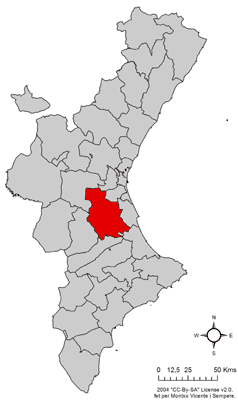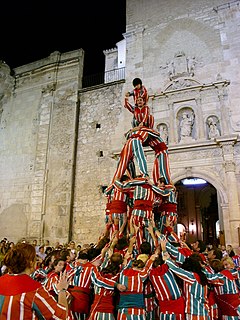
The Muixeranga is the collective name given to the performance of ancient street dances and human pyramids or castells, originating in the ancient Kingdom of Valencia, which are still preserved in the town of Algemesí, 30 km (19 mi) southwest from Valencia, and certain other Valencian towns.

Alzira is a city and municipality of 44,938 inhabitants in Valencia, eastern Spain. It is the capital of the comarca of Ribera Alta in the province of Valencia. The city is the heart of the second largest urban agglomeration in the province, with a population of over 100,000.
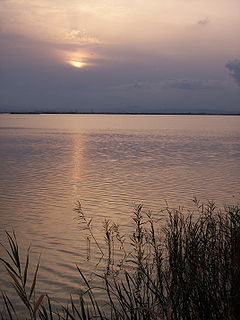
The Albufera, La Albufera or L'Albufera de València, is a freshwater lagoon and estuary on the Gulf of Valencia coast of the Valencian Community in eastern Spain. It is the main portion of the Parc Natural de l'Albufera de València, with a surface area of 21,120 hectares. The natural biodiversity of the nature reserve allows a great variety of flora and fauna to thrive and be observed year-round. Though once a saltwater lagoon, dilution due to irrigation and canals draining into the estuary and the sand bars increasing in size had converted it to freshwater by the seventeenth century.

Carcaixent is a town and municipality in the province of Valencia, eastern Spain, with c. 20,000 inhabitants. Its origins go back to prehistoric Iberian and Roman times, with some remainders in its area. It is located in the Ribera Alta comarca, 40 km south of the provincial capital Valencia. It is the birthplace of the orange growth and its flourishing commerce in the 19th and 20th centuries. Currently, its inhabitants live basically on agriculture and the service sector.

Cullera is a city and municipality of Spain located in the Valencian Community. It is part of the province of Valencia and the Ribera Baixa comarca. The city is situated near the discharge of the river Júcar in the Mediterranean Sea.
The Divisiones Regionales de Fútbol in the Valencian Community, are organized by the Valencian Football Federation:

Algemesí is a municipality in the comarca of Ribera Alta in the Valencian Community, Spain.

Càrcer is a municipality in the comarca of Ribera Alta in the Valencian Community, Spain.

La Pobla Llarga is a municipality in the comarca of Ribera Alta in the Valencian Community, Spain. Well known of the orange growth and its flourishing commerce in the 19th and 20th centuries. Currently, its inhabitants live basically on agriculture and the service sector.

Sollana is a municipality in the comarca of Ribera Baixa in the Valencian Community, Spain. The municipality includes a second village: El Romaní.
Julián Ribera y Tarragó was a Spanish Arabist and academic.

The Valencian Community, or simply Valencia, is an autonomous community of Spain. It is the fourth most populous Spanish autonomous community after Andalusia, Catalonia and Madrid with more than five million inhabitants. Its homonymous capital Valencia is the third largest city and metropolitan area in Spain. It is located along the Mediterranean coast on the east side of the Iberian Peninsula. It borders with Catalonia to the north, Aragon and Castilla–La Mancha to the west, and Murcia to the south. The Valencian Community consists of three provinces which are Castellon, Valencia and Alicante.
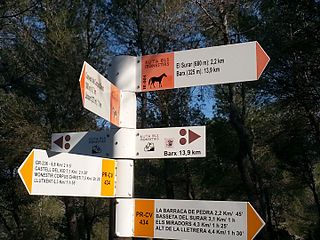
The Route of the Monasteries of Valencia (GR-236) is a religious and cultural route that connects five monasteries located in central region of the Province of Valencia,, in Spain. The Route was inaugurated in the year 2008.
Valencians are the native people of the Valencian Community, in eastern Spain. Legally, Valencians are the inhabitants of the community. Since 2006, the Valencian people are officially recognised in the Valencian Statute of Autonomy as a nationality "within the unity of the Spanish nation". The official languages of Valencia are Valencian and Spanish.

La Pobla de Vallbona is a municipality in the province of Valencia in the Valencian Community, Spain.

The Festivity of La Mare de Déu de la Salut is a festival celebrated in Algemesí (Valencia), Spain, from August 29 to September 8. The festival is in honour of the patron saint of Algemesí, La Mare de Déu de la Salut, and has been dated back to 1247. The holiday was awarded the UNESCO "Masterpieces of the Oral and Intangible Heritage of Humanity" designation on November 28, 2011.

Valencia is a province of Spain, in the central part of the autonomous Valencian Community. Of the province's over 2.5 million people (2018), one-third live in the capital, Valencia, which is also the capital of the autonomous community and the 3rd biggest city in Spain, with a metropolitan area of 2,522,383 people it is also one of the most populated cities of Southern Europe. There are 265 municipalities in the province.

The Alarcón Dam is a gravity dam on the upper course of the Júcar River. It is located 6 kilometres (3.7 mi) from Alarcón, in the province of Cuenca, in the autonomous community of Castilla-La Mancha, Spain.
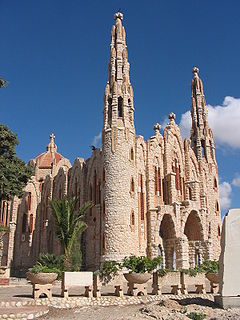
Valencian Art Nouveau, is the historiographic denomination given to an art and literature movement associated with the Art Nouveau in the Valencian Community, in Spain.
